Even Hipster Hamsters Will Love It!
New in 2015, the 2016 Soul EV has been updated with a longer driving range and continues to be the fun, zip-around-town car it was when it debuted. The Soul EV is a kick to drive and, of course, you won’t spend a dime on gas, oil and tune-ups. Got your attention?
Drivetrain
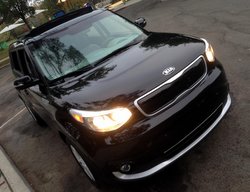
The front-wheel drive 2016 Soul EV is powered by a 90kW electric motor good for 109 hp and 210 lb-ft of torque. It has an EPA range estimate of 93 miles, equal or just a bit more than many of Soul’s EV competitors—the Nissan Leaf, Chevrolet Spark, VW e-Golf and Fiat 500e. Of course the field is in flux as many higher-range models are being introduced. The Tesla Model S and X, which cost three times as much as the Soul EV, can go further on a charge.
The Soul EV is currently (November 2016) available in 10 states: CA, CT, GA, HI, OR, MD, NJ, NY, OR and TX. Since it is not designed for long road trips, staying in your town or state should not be an issue. The Soul, which also comes in a gasoline version, is considered a city car and for the most part should be considered for that exact use.
A lithium-ion polymer battery (Li-Ion for short) packs the power for the Soul EV. Charging is accomplished through a regenerative braking system while driving. For a full charge it has two plug-in ports capable of three charging speeds:
- 120V (Level 1) – 24 hours – Discharged to a full charge
- 240V (Level 2) – Five hours – Discharged to a full charge
- 480V (Level 3) – 33 minutes – Discharged to an 80 percent charge
The regenerative braking system converts braking or coasting into electricity, which charges the battery. The state of charge and mileage range are metered by dashboard gauges. It is quite

common to start an in-town journey of stop-and-go driving, only to return with more range or only a few miles depleted from the beginning range. However, where the regenerative braking system does not offer any help in charging the battery or adding to the driving range is on the highway. Cruising along at 55–65 mph over an extended period will result in the battery charge and driving range depleting right before your eyes.
All Kia dealers that sell the Soul EV have Level 2 chargers and offer free charging to any Soul EV owner.
Driving Experience: On the Road
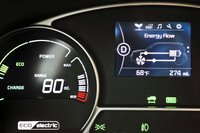
Available in three trims—Soul EV-e, Soul EV and Soul EV+—the entire line-up has an EPA estimated mpge (miles per gallon equivalent, which equates the energy found in a gallon of gasoline to electricity) of 92 mpge highway/120 mpge city/105 mpge combined. The power is immediate with torque at any speed and gets you to 60 mph in about 12 seconds with an electronically limited top speed of 90 mph.
The Soul EV weighs in at 3,289 lbs. (which is part of why the car isn’t a speedster) and is evenly distributed as the Li-Ion batteries are located low and under the seats. This balance helps with good handling and an adequate combination for normal corning with the Nexen 205/60R/16 N’Blue tires, which are a different tire from what is found on the gasoline-powered Soul. Nexen says the N’Blue tires are designed to maximize vehicle range while delivering good performance on dry, wet and even light snow conditions.
Steering is through a column-mounted electric motor-driven system with front independent MacPherson struts and coil springs, and a rear coupled torsion beam suspension. Around town the
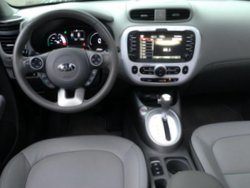
Soul EV+ is really in its element. Whether it is maneuvering through traffic or parking with ease, you will be patting yourself on the back for owning this car. Overall, the Soul EV+ felt sprightly, stable on the highway and was fun to drive.
Stopping comes from front and rear active hydraulic boost-assisted, vented disc brakes with ABS, which are part of Kia’s regenerative braking system. The stops were straight and consistent. As can be common with regenerative braking systems, the brakes were not touchy nor did they produce a noticeable whine.
Driving Experience: Exterior
The Soul EV has the same body design as the gasoline-powered version, with a few tweaks differentiating the two including color options, unique wheels, “eco electric” fender badging, LED head and taillights, projection fog lamps and a different front fascia that includes the charge port door centered in the grill. Overall, the Soul EV has an identifiable shape that is unique among hatchbacks.
Driving Experience: Interior
Clean Fleet Report’s 2016 Soul EV+ came with the optional $1,100 Sun & Fun Package that included a panoramic sunroof, LED interior lighting, an illuminated AUX/USB port and very cool speaker lights. These lights surround the round, front door speakers and are controlled by a dash knob that allows for a red light to pulse with the audio or multi-colors that change at a regular interval. Necessary, no. Differentiator from the pack, yes.
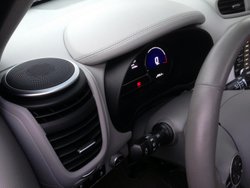
Standard equipment on the Soul EV+ includes a six-speaker SiriusXM/FM/CD/AMHD/MP3 sound system, all managed through an eight-inch color capacitive touchscreen, with voice-command, navigation, rear back-up camera, Bluetooth for hands free telephone operation and music streaming.
Convenience features include power windows and heated power outside mirrors, heated and leather-wrapped steering wheel with cruise and audio/telephone controls, push button start/stop, automatic climate control, tilt and telescopic steering column and Kia’s UVO infotainment system.
Our Soul EV+ had heated and ventilated leather-trimmed seats, with accent piping, for the driver and passenger. Their manual adjustments offered the ability to find a comfortable position, even for tall drivers, including good thigh support.The rear outboard seats are heated, split 60/40 and easily accommodate a 6’ passenger. Cup holders abound front and back; the soft-touch dash and upper door panels had a good feel and look.
The cockpit design is driver-friendly and roomy with ample storage space behind the rear seats and even more with the seats folded flat. The gauges and controls are in easy sight and reach, and all are easy to understand. A unique feature aiming to reduce energy use is the button that isolates the ventilation only to the driver, eliminating running the climate system for the full interior when it is not needed.
Safety, Warranties and Pricing
Kia equips the Soul EV with active and passive safety features, including six air bags, a tire pressure monitoring system, hill start assist, electronic stability control, vehicle stability management
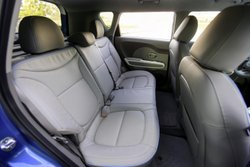
and the four-wheel disc brakes with ABS.
Depending on your taxable income and where you live, you could potentially reduce your final purchase price by as much as $10,000 through federal and state programs. It is recommended to contact your CPA before finalizing a Soul EV purchase so you are completely clear on the tax credits and incentives. Not relying on the dealer to provide this information will serve them and you best.
2016 Soul EV pricing before any federal or state tax programs, and excluding the destination charge of $850 is:
EV-e – $31,550
EV – $33,950
EV+ – $35,950
Clean Fleet Report’s 2016 Soul EV+ had a MSRP of $37,175, not including the $850 destination charge.
The 2016 Soul EV comes with these warranties:
- Powertrain – 10 years/100,000 miles
- Battery – 10 years/100,000 miles
- Basic – Five years/60,000 miles
- Roadside Assistance – Five years/60,000 miles
- Anti-Perforation – Five years/100,000 miles
Observations: 2016 Kia Soul EV+
If you are reading this, the possibility of owning an electric car must be close to becoming a reality. Here at Clean Fleet Report we are big fans of EVs, but would never propose you buy one unless you are completely familiar with their capabilities—and limitations.
EV ownership considerations include:
- How far you drive daily,
- If, when you get to your destination, can you recharge the battery and
- Do you have access to a gasoline-powered vehicle for longer trips.
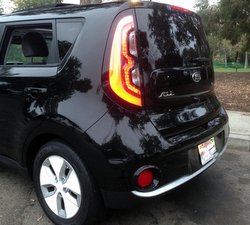
It doesn’t sound like much, but these factors are no small thing when owning a plug-in, fully electric car. If 90-percent of your driving is within 75 miles of your house, a Soul EV could be right for you as you would never need to buy gasoline again. Ever. But what about a longer trip where the Soul EV range can’t get you there and back? In this case, the Soul EV would be your second car or you would rent a car for the day, weekend or week.
With all considerations understood, the 2016 Kia Soul EV+ offers a cool factor not found with other EVs. It features good passenger room and comfort, a nicely appointed interior and peppy performance, all making for a nice driving experience. One thing you will enjoy is how quiet and smooth driving an EV will be. There is nothing like it, and you will become spoiled very quickly.
Before visiting your local Kia dealer, call ahead and make an appointment with one of their certified EV sales representatives. Do not speak with anyone at any dealership, regardless of brand, that has not gone through the factory training and education programs of what makes an electric vehicle unique, which includes its benefits and limitations. Once at the dealership, make sure to take a lengthy test drive, which replicates your longest and most common trip, as this is the only way to truly see if the 2016 Soul EV+ is right for your lifestyle.
Whatever you end up buying, enjoy your new car and as always, Happy Driving!
Related Stories You Might Enjoy:
First Drive: 2015 Kia Soul EV
Test Drive: 2016 Nissan Leaf
Test Drive: 2014 Chevrolet Spark
Test Drive: 2014 Volkswagen e-Golf
Test Drive: 2016 Fiat 500e
Test Drive: 2014 BMW i3
Disclosure:
Clean Fleet Report is loaned free test vehicles from automakers to evaluate, typically for a week at a time. Our road tests are based on this one-week drive of a new vehicle. Because of this we don’t address issues such as long-term reliability or total cost of ownership. In addition we are often invited to manufacturer events highlighting new vehicles or technology. As part of these events we may be offered free transportation, lodging or meals. We do our best to present our unvarnished evaluations of vehicles and news irrespective of these inducements.
Our focus is on vehicles that offer the best fuel economy in their class. We also feature those that are among the top mpg vehicles in their class. In addition, we aim to offer reviews and news on advanced technology and the alternative fuel vehicle market. We welcome any feedback from vehicle owners and are dedicated to providing a forum for alternative viewpoints. Please let us know your views at publisher@cleanfleetreport.com.

12 thoughts on “Road Test: 2016 Kia Soul EV”